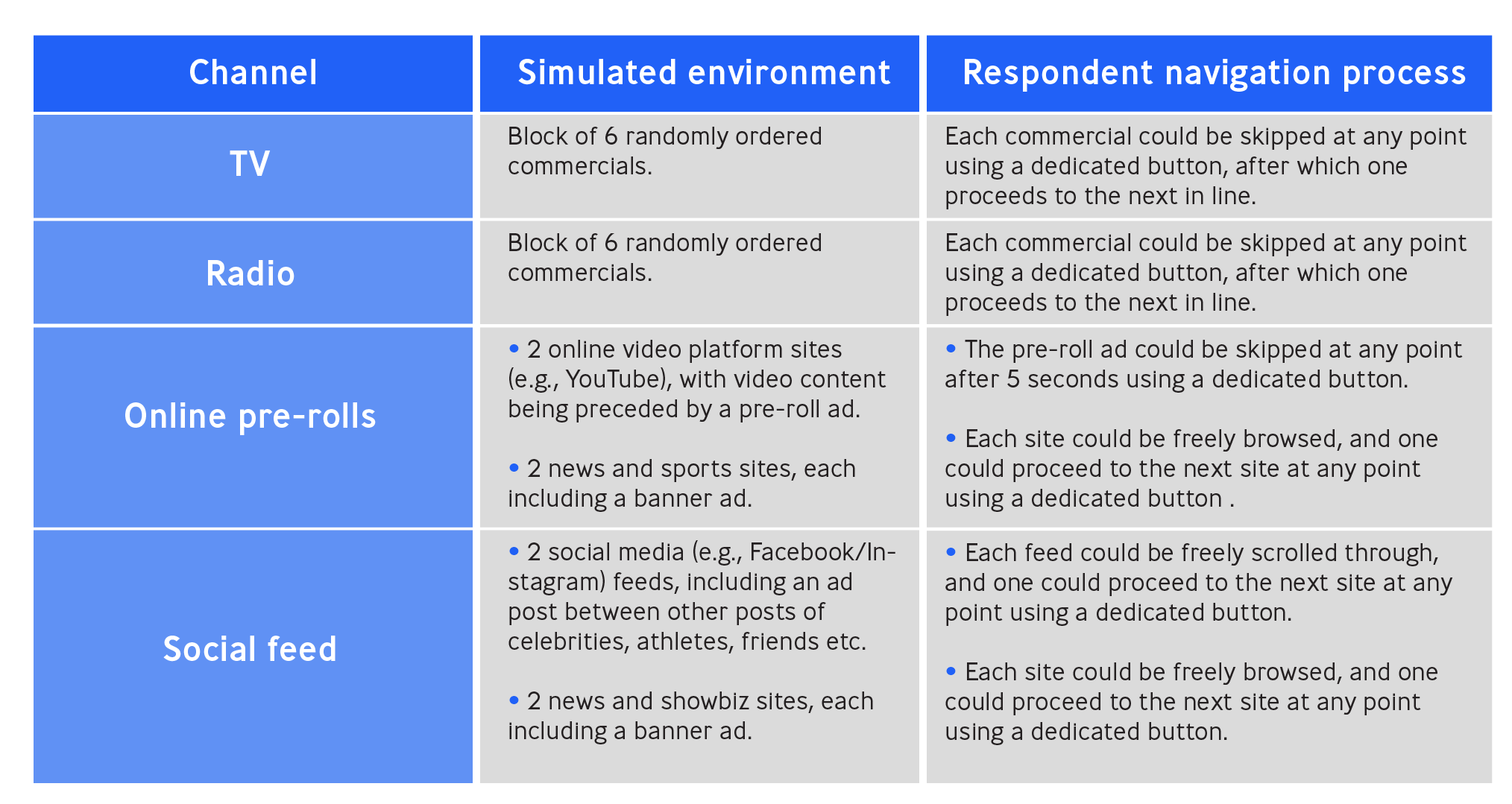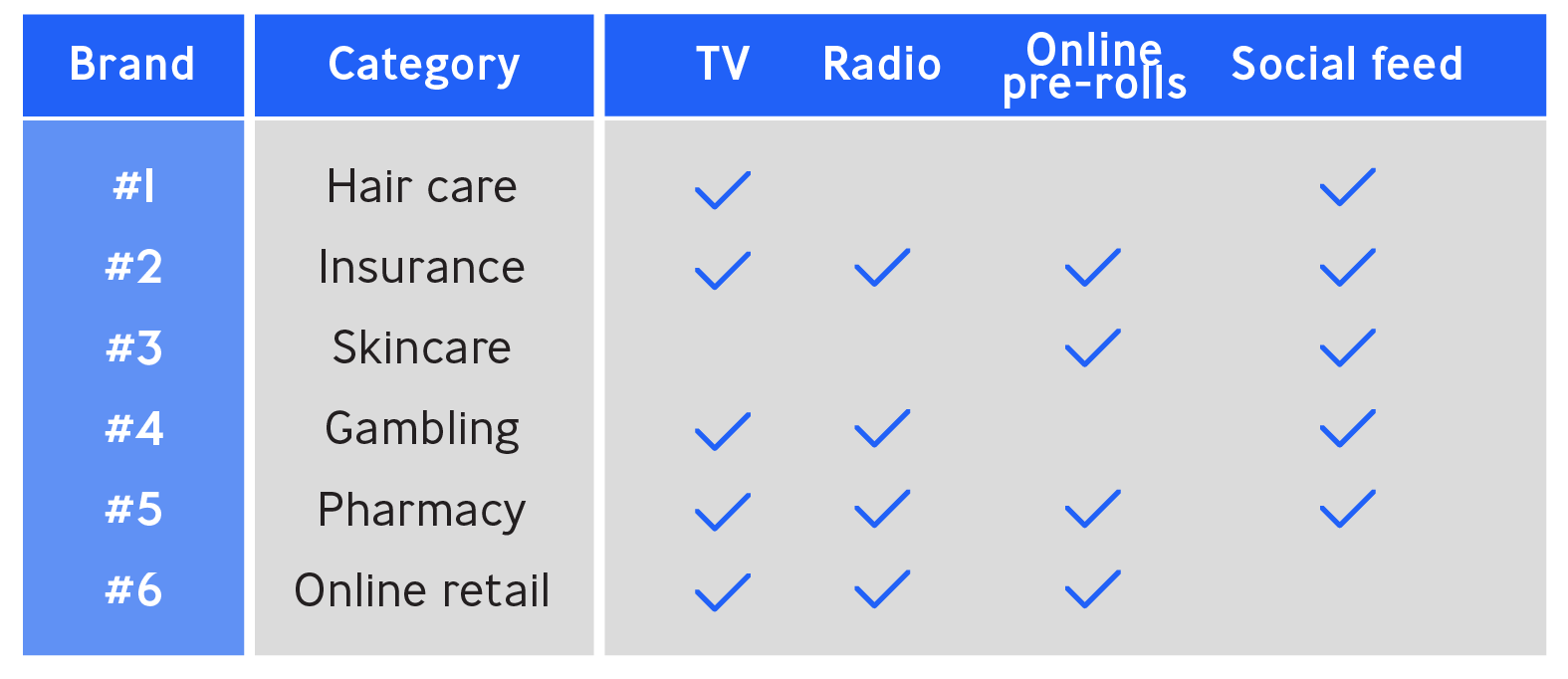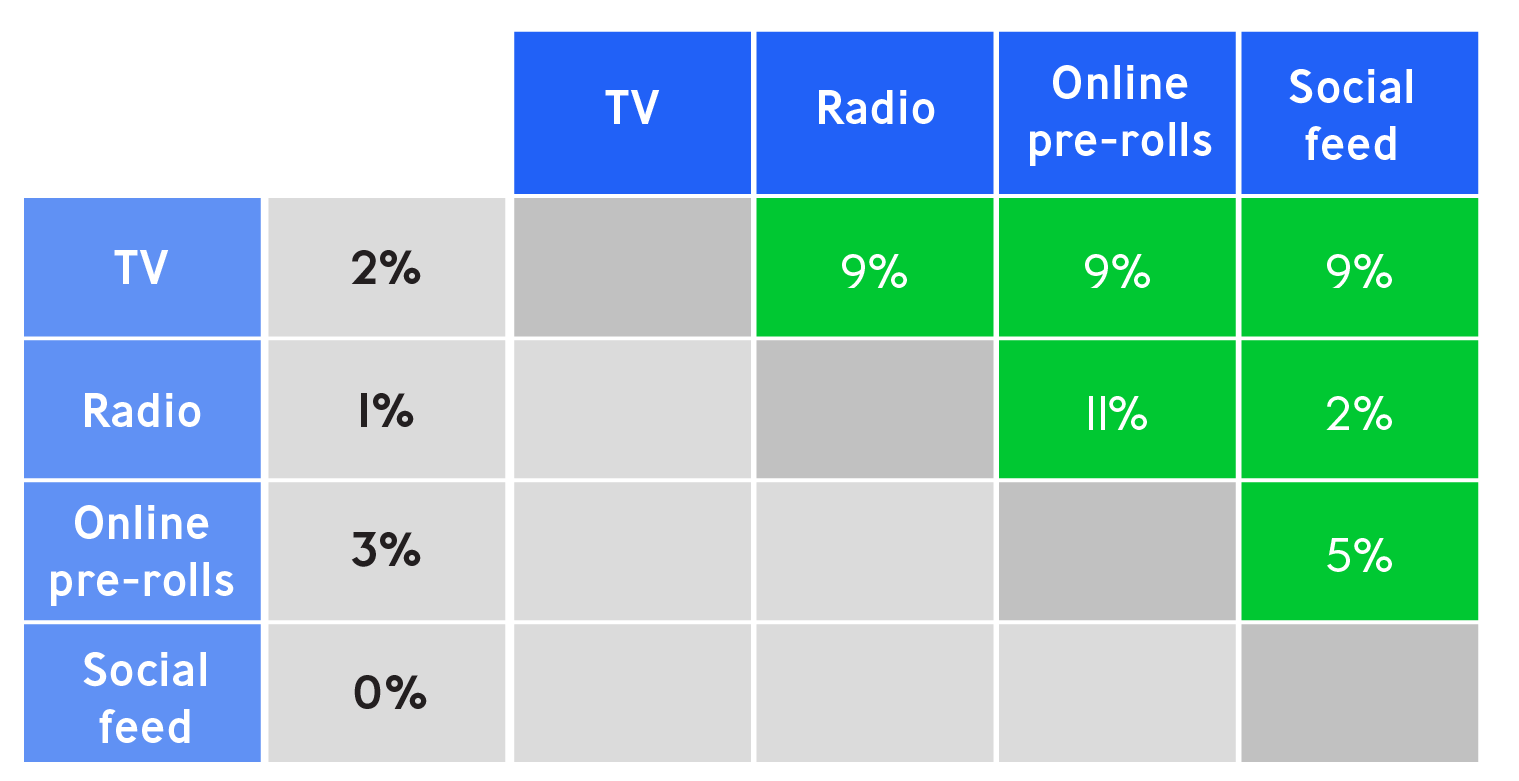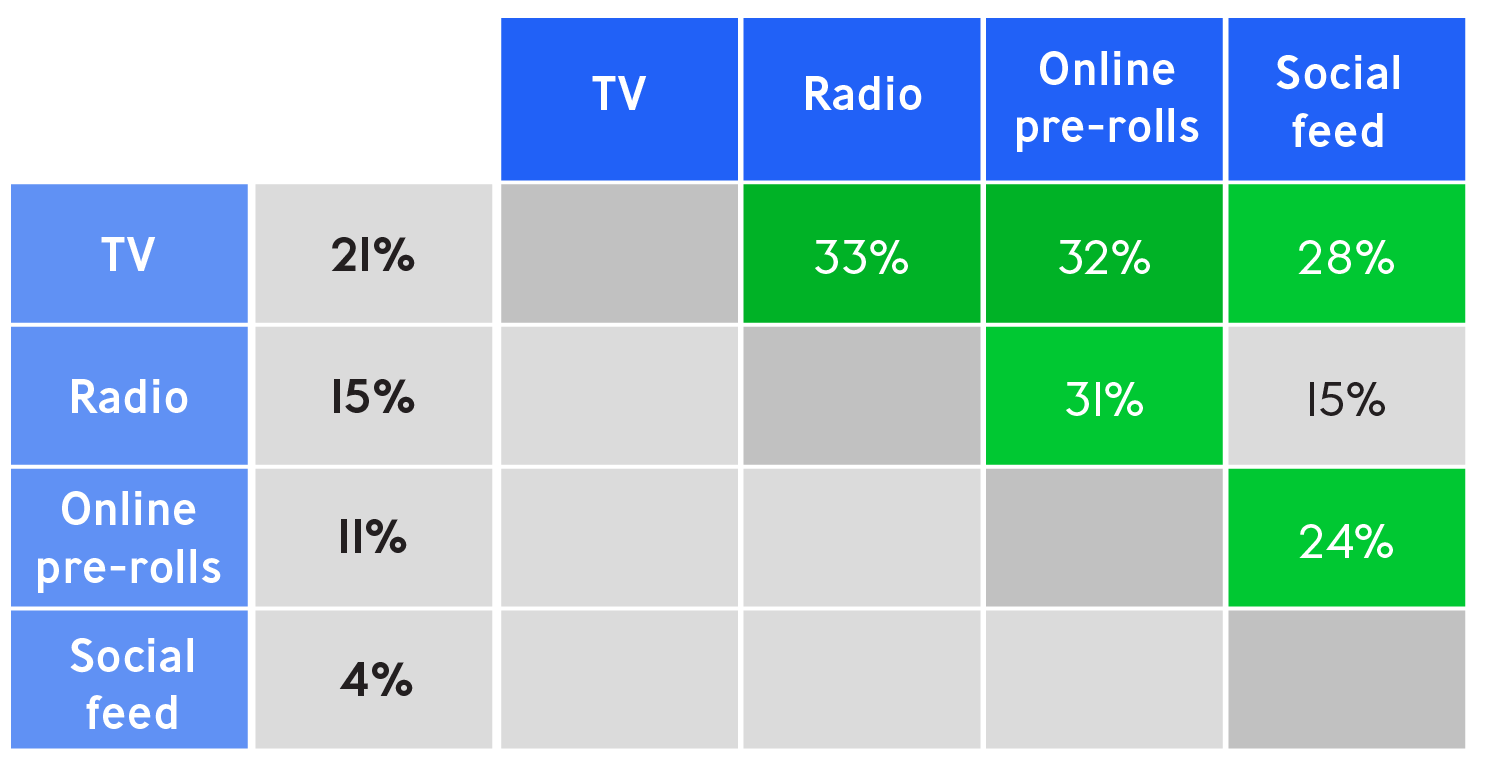Memory synergies in cross-media advertising
Gepubliceerd op 08 03 2023AN EXPLORATIVE STUDY ON THE IMPACT OF CROSS-MEDIA AD EXPOSURE ON BRAND RECALL
Mark Vroegrijk, Senior Methodologist
In today’s advertising landscape, many brands opt for a “cross-media” approach to their advertising campaigns, in which multiple media channels (e.g., TV, radio, online platforms) are jointly used to convey the campaign’s main message to its audience. Such a strategy is typically motivated by the desire to maximise the campaign’s reach. Because different audience segments (e.g., based on age) tend to use different media channels, advertising across various channels can help increase the number of consumers eventually exposed to the campaign.
At the same time, spreading one’s advertising efforts across multiple channels may also help in increasing the campaign’s (exposure) frequency. Despite channels differing in popularity among different types of consumers, today’s reality is that a vast majority of people use a multitude of channels for their media consumption. For example, a typical consumer may browse news on his smartphone during the train ride to work, listen to the radio at the office, check his social media accounts during the commute back home, and watch TV after dinner. If these channels are all potential “touchpoints” with an advertising campaign, it follows that the average number of exposures per consumer is expected to rise as well.
This potential increase in frequency resulting from a cross-media strategy got us interested in its implications in terms of campaign effectiveness. Specifically, we would like to explore:
- the extent to which a campaign becomes more impactful in case the number of exposures, realised across multiple channels, increases,
- which specific channel combinations are more effective in this regard?
A STUDY OF IMPACT UNDER DIFFERENT EXPOSURE SCENARIOS
To gain more insights into the two research questions formulated above, we set up an online survey administered among ±1.300 Dutch consumers, in which we first exposed each respondent to several ads across several channels in random order. We presented the ads in a “natural-like” environment for each channel, aiming to resemble how advertising is displayed to consumers on that channel in reality. In addition, we allowed respondents to pay as much or as less attention to the ads as they liked because advertising avoidance is a common phenomenon among consumers and exposure thus does not necessarily equal (undivided) attention. Table 1 details which channels were included in our study, how their environments were operationalised, and how respondents could navigate through these environments.
Table 1: Description of simulated environment and respondent navigation process per studied channel

STUDY SETUP
Across the four environments, each respondent was exposed to 20 ads; 10 filler ads in which we’re not particularly interested and 10 ads from six “focal” brands. Through randomised allocation, two of these “focal” brands were represented by a single ad (on a single channel), while the other four were represented by two ads (across two channels). The specific channel(s) allocation for ads was determined randomly, but also depended on which channels were and were not used in the actual running campaign. Table 2 provides an overview of these six brands, the category each brand belongs to, and the channels on which an advertising asset was available.
Finally, after the respondent navigated through the four channel-specific environments and answered a set of “distraction” questions, we gauged the initial impact of single- versus multi-channel exposure by means of an open-ended brand recall question; “Please name each brand that you remember seeing/hearing across the different environments”. After all, an absolute requirement for advertising to be effective in improving brand performance is that consumers can remember what brand the advertising was for.
Table 2: Availability of channel-specific assets for the six focal brands

DOES CROSS-MEDIA EXPOSURE IMPROVE BRAND RECALL?
We start our discussion of the study’s results by focusing on top-of-mind brand recall, i.e. the percentage of respondents naming the brand as the very first one in the open-ended recall question. Table 3 displays the average top-of-mind brand recall scores (across the six focal brands), both for the single-exposure (the leftmost column) and dual-exposure (the “cross” cells corresponding to each possible pair of channels) scenarios.
Table 3: Average top-of-mind brand recall scores for single- (non-bold values & white cells) and dual-exposure (bold values) scenarios

 The first striking result is that top-of-mind recall levels remained very limited (3% or lower) when respondents only saw a single ad of the brand; although this logically follows from the fact that each respondent was exposed to a large (20) number of ads across the four environments. At the same time, these scores notably increased in case the respondent saw two ads of the brand instead. This shows that a larger number of potential “memory hooks”, resulting from being exposed to the brand across multiple channels, indeed boosts the likelihood that the brand will stick in the consumer’s memory afterwards. More specifically, we find the largest uplifts for the following combinations which thus proved particularly effective in fostering top-of-mind brand recall:
The first striking result is that top-of-mind recall levels remained very limited (3% or lower) when respondents only saw a single ad of the brand; although this logically follows from the fact that each respondent was exposed to a large (20) number of ads across the four environments. At the same time, these scores notably increased in case the respondent saw two ads of the brand instead. This shows that a larger number of potential “memory hooks”, resulting from being exposed to the brand across multiple channels, indeed boosts the likelihood that the brand will stick in the consumer’s memory afterwards. More specifically, we find the largest uplifts for the following combinations which thus proved particularly effective in fostering top-of-mind brand recall:
- TV + Radio with 9% versus TV-only (2%) and Radio-only (1%)
- Radio + Pre-roll with 11% versus Radio-only (1%) and Pre-roll only (3%)
Other channel combinations added less value such as the Social Feed and Pre-roll (5%) and especially Social Feed and Radio (2%). This seems to be driven by a general difficulty experienced by consumers in recalling the brand from social feed advertising (which may be in turn driven by a relative lack of attention) because as we already saw, there was an expected 0% top-of-mind recall score in the case when the respondent only saw the brand through that channel.
SYNERGY EFFECT AT ITS BEST
Next, we turn our attention to the results for unaided brand recall, i.e. the percentage of respondents naming the brand at any point in the open-ended recall question. Table 4 again displays all single- and dual-channel scores. We see that when we consider channels on their own (single exposure), TV is more effective in fostering unaided brand recall (21%) than radio and online pre-rolls (15% and 11%, respectively), which are in turn more effective than social feed advertising (4%).
Table 4: Average unaided brand recall scores for single- (non-bold values & white cells) and dual-exposure (bold values) scenarios


At the same time, when we look at the recall scores under the dual-exposure scenarios, we see several combinations that do not include TV quickly “catching up” to those that do. For example, exposure to a radio and an online pre-roll ad results in the almost same rate of recall (31%) as TV + Radio (33%) or TV + Pre-roll (32%) scenario.
This combination thus shows strong signs of so-called “synergies“, which means that the whole is greater than the sum of its parts. More specifically, recall following from combined exposure to a radio and pre-roll ad (31%) is 5 percentage points higher than the sum of recall rates for both channels individually (15% for radio, plus 11% for pre-rolls → 26% in total). An even more synergetic combination is the one between online pre-rolls and social feed advertising; even though the rate of recall under this combination (24%) is somewhat lower than combinations including TV, we still observe a 9 percentage-point recall uplift compared to the sum of the individual channels’ recall scores (11% for pre-rolls plus 4% for social feed → 15% in total).
However, on the other side of the spectrum, we again see the combined exposure to a radio and social feed ad underperforming which is similar to the results for top-of-mind recall. The recall score under this scenario equals 15% and remains exactly the same as when the consumer was only exposed to the radio ad. Therefore, we can conclude that compared to a radio-only scenario, additional exposure through a social feed does not bring any added value in terms of consumers’ ability to recall the brand afterwards.
AN EFFECTIVE WAY OF IMPROVING BRAND-CAMPAIGN LINKAGE
Taken together, the results from our study show that an increase in exposure frequency, followed by advertising across multiple channels, leads to a more effective campaign – at least in terms of subsequent brand recall.
- We see for example that if a brand realises an additional campaign exposure (compared to other brands) on a different channel, it notably increases the likelihood that the brand becomes the very first to be remembered (top-of-mind) afterwards.
- For unaided brand recall, two exposures across different channels are more impactful than a single exposure on one channel – although the effects are somewhat smaller in (relative) size.
When we simultaneously consider the uplifts in top-of-mind and unaided brand recall, we also obtained some interesting insights into the relative effectiveness of specific channel combinations in fostering brand memorisation.
- Channel combinations with TV generally result in high recall rates. However, the added value of the second channel is generally smaller – because exposure to a TV ad on its own already has a substantial impact on recall.
- In contrast, more pronounced “synergies” are found for the Radio + Pre-roll and Social Feed + Pre-roll combinations. This could be the result of a common element which is the “guaranteed” attention to at least the first few seconds of a pre-roll This might make it easier for consumers to recognise or recall the brand’s appearance in a radio commercial block or on their social feed, which consequently increases the effectiveness of this additional exposure.
- However, we observe that Radio + Social Feed combination lacks such a synergy effect. The absence of visual elements in the former and fleeting consumer attention for the latter may cause these channels to lack the ability to reinforce one another.
Naturally, it should be noted that this study was conducted in a highly simulated setting, in which campaign exposures across different channels occurred in quick succession (as opposed to being spread across multiple hours, days or even weeks). Still, it provides a strong indication that advertising across multiple channels can strongly increase the potential of memorising the campaign, and helps identify what channel combinations are particularly effective in achieving that goal.
When we simultaneously consider the uplifts in top-of-mind and unaided brand recall, we also obtained some interesting insights into the relative effectiveness of specific channel combinations in fostering brand memorisation.
- Channel combinations with TV generally result in high recall rates. However, the added value of the second channel is generally smaller – because exposure to a TV ad on its own already has a substantial impact on recall.
- In contrast, more pronounced “synergies” are found for the Radio + Pre-roll and Social Feed + Pre-roll combinations. This could be the result of a common element which is the “guaranteed” attention to at least the first few seconds of a pre-roll This might make it easier for consumers to recognise or recall the brand’s appearance in a radio commercial block or on their social feed, which consequently increases the effectiveness of this additional exposure.
- However, we observe that Radio + Social Feed combination lacks such a synergy effect. The absence of visual elements in the former and fleeting consumer attention for the latter may cause these channels to lack the ability to reinforce one another.
Naturally, it should be noted that this study was conducted in a highly simulated setting, in which campaign exposures across different channels occurred in quick succession (as opposed to being spread across multiple hours, days or even weeks). Still, it provides a strong indication that advertising across multiple channels can strongly increase the potential of memorising the campaign, and helps identify what channel combinations are particularly effective in achieving that goal.